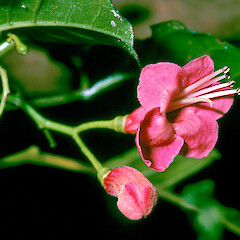Vitex lucens
Common name
pūriri
Synonyms
Vitex littoralis A.Cunn.
Family
Lamiaceae
Flora category
Vascular – Native
Endemic taxon
Yes
Endemic genus
No
Endemic family
No
Structural class
Trees & Shrubs - Dicotyledons
NVS code
The National Vegetation Survey (NVS) Databank is a physical archive and electronic databank containing records of over 94,000 vegetation survey plots - including data from over 19,000 permanent plots. NVS maintains a standard set of species code abbreviations that correspond to standard scientific plant names from the Ngä Tipu o Aotearoa - New Zealand Plants database.
VITLUC
Chromosome number
2n = 64
Current conservation status
The conservation status of all known New Zealand vascular plant taxa at the rank of species and below were reassessed in 2017 using the New Zealand Threat Classification System (NZTCS) – more information about this can be found on the NZTCS website. This report includes a statistical summary and brief notes on changes since 2012 and replaces all previous NZTCS lists for vascular plants.
Please note, threat classifications are often suggested by authors when publications fall between NZTCS assessment periods – an interim threat classification status has not been assessed by the NZTCS panel.
- Conservation status of New Zealand indigenous vascular plants, 2017 . 2018. Peter J. de Lange, Jeremy R. Rolfe, John W. Barkla, Shannel P. Courtney, Paul D. Champion, Leon R. Perrie, Sarah M. Beadel, Kerry A. Ford, Ilse Breitwieser, Ines Schönberger, Rowan Hindmarsh-Walls, Peter B. Heenan and Kate Ladley. Department of Conservation. Source: NZTCS and licensed by DOC for reuse under the Creative Commons Attribution 4.0 International licence.
2017 | Not Threatened
Previous conservation statuses
2012 | Not Threatened
2009 | Not Threatened
2004 | Not Threatened
Brief description
Large tree with thin pale flaky bark over an uneven knobbly trunk bearing dark green leaves made of five wrinkled leaflets radiating from the top of a stalk, largest leaflet in the middle, flowers pink, bell-shaped with projecting pale filaments, fruit 2cm wide and red.
Distribution
Endemic. New Zealand: Three Kings Islands and North Island from Te Paki to Taranaki, Mahia Peninsula and the northern Hawke’s Bay. Puriri is, as a rule, scarce south of about Opotiki and Kawhia.
Habitat
In the northern part of its range Puriri is a common co-dominant with Taraire (Beilschmiedia tarairi) and karaka (Corynocarpus laevigatus) especially on rich fertile soils derived from basaltic and basaltic-andesitic igneous rocks. South of the northern Bay of Plenty and Raglan Harbours it is rarely found inland and is more commonly found in coastal forest where it co-habits with pohutukawa (Metrosideros excelsa) and karaka. Puriri is also an important forest tree on many of the smaller islands of the Hauraki Gulf, where it may at times be the canopy dominant.
Wetland plant indicator status rating
Information derived from the revised national wetland plant list prepared to assist councils in delineating and monitoring wetlands (Clarkson et al., 2021 Manaaki Whenua – Landcare Research Contract Report LC3975 for Hawke’s Bay Regional Council). The national plant list categorises plants by the extent to which they are found in wetlands and not ‘drylands’. The indicator status ratings are OBL (obligate wetland), FACW (facultative wetland), FAC (facultative), FACU (facultative upland), and UPL (obligate upland). If you have suggestions for the Wetland Indicator Status Rating, please contact: [Enable JavaScript to view protected content]
UPL: Obligate Upland
Rarely is a hydrophyte, almost always in uplands (non-wetlands).
Detailed description
Tree up to c. 20 m. tall with a broad spreading canopy; trunk up to c.1·5 m. diamete; bark grey-brown, firm, flaking in small irregular-shaped shards. Branches stout, spreading; branchlets 4-angled, green. Leaves opposite, glabrous, coriaceous, compound, on petioles up to 110 mm long; Leaflets 3-4-5, somewhat undulose, adaxially dark green, glossy, abaxially lighter green, mat; basal one or pair of leaflets usually much smaller than the terminal 3, digitate; lamina of 3 main leaflets 50-140 × 30-60 mm; elliptic-oblong to obovate, abruptly acute to subacuminate, margin entire. Domatia (pit-type) present at axils of costa and main veins. Inflorescence in axillary, dichotomous, (4)-10-15-flowered panicles. Calyx cupular, minutely 5-toothed; corolla dull red, pink or white, pubescent, 2-lipped, c.25-35 mm long. Upper lip entire or bifid, lower deflexed, 3-lobed. Style slender, bifid, c.25 mm long. Drupe 20-26 mm diameter subglobose, bright red, pink or white.
Similar taxa
None
Flowering
May - October
Flower colours
Red/Pink, White
Fruiting
January - October
Propagation technique
Easily grown from seed. Seed can be slow to germinate, although germination can be hastened by scarifying the seed coat. Seedlings and saplings are frost tender and require a sheltered, warm, semi-shaded site (at least initially to thrive). Puriri prefers a rich, deep, fertile soil but is surprisingly tolerant of a range of conditions including drought (once established). This is a spectacular specimen tree that deserves to be more widely cultivated than it is. It makes an excellent street/avenue or park tree, and the flowers attract birds (especially tui and bellbird) and the fruits kereru
Threats
Not Threatened. However, in some parts of Northland puriri “die-back” has been observed (the exact causes of which are much debated). Puriri is at times heavily browsed by possums, to such an extent that trees can die.
Etymology
vitex: To wieve or tie up, chaste
lucens: Shining
Attribution
Factsheet prepare for NZPCN by P.J. de Lange 9 February 2011. Description adapted from Allan (1961).
References and further reading
Allan, H.H. 1961: Flora of New Zealand. Vol. I, Wellington, Government Printer.
NZPCN Fact Sheet citation
Please cite as: de Lange, P.J. (Year at time of access): Vitex lucens Fact Sheet (content continuously updated). New Zealand Plant Conservation Network. https://www.nzpcn.org.nz/flora/species/vitex-lucens/ (Date website was queried)





















